HMS Defender was formally welcomed back into the fleet last week by Commodore Craig Wood, Commander of the Portsmouth Flotilla, after a series of trials to prove her upgrades was declared a success.
The Type 45 Destroyer received two new gas turbines, as well as new signals intelligence and surveillance equipment.
Commanding officer of HMS Defender, Commander Richard Hewitt, said:
“I am incredibly proud to have taken HMS Defender to sea for the first time in 18 months thanks to the hard work of Team Portsmouth, BAE Systems, and my ship’s company.
With a number of major capability upgrades, HMS Defender is now the most capable Type 45 in the fleet.”
We recently reported that a contract to fully rectify issues within the Type 45 Destroyer fleet will be awarded in 2018, this was again confirmed in Parliament.
Asked by Flick Drummond, Member for Portsmouth South:
“To ask the Secretary of State for Defence, when he plans to award contracts for the Power Improvement Project for the Type 45 destroyer class.”
Answered by: Harriett Baldwin, Parliamentary Under-Secretary for the Ministry of Defence:
“On current plans, we anticipate that the Ministry of Defence will be able to award the contract for the Power Improvement Project for the Type 45 Destroyer class in early 2018.”
In 2015, the Ministry of Defence acknowledged that the vessels propulsion system, specifically, the Northrup Grumman intercooler was experiencing reliability issues, previously reported as nothing more than “teething troubles”.
A staggered refit was also announced, which will involve cutting into the ships’ hulls and fitting additional diesel generation capacity, this has become known as Project Napier.
According to the Royal Institute of Naval Architects:
“Project Napier was established in 2014 with two core work strands. The first of these, known as the Equipment Improvement Plan (EIP), is continuing efforts to enhance system reliability and to meet the original design intent in the near term.
The second component of Project Napier is a longer term Power Improvement Plan (PIP), intended to improve overall system resilience by adding upgraded diesel generators to provide the electrical generation capacity required to meet the overwhelming majority of propulsion and ship power requirements without reliance on WR-21.”
Project Napier will cost £280 million.
The reliability issues with the intercooler lead to occasional near-complete power generation failures, temporarily disabling not only propulsion, but power generation for weapons, navigational systems, and other purposes, leaving the ships vulnerable to “total electric failure”.
HMS Daring’s engines failed in the mid-Atlantic in 2010 and had to be repaired in Canada, with further repairs for engine failure in 2012 in Bahrain after it encountered propulsion problems while on patrol off the coast of Kuwait.
Two years ago, Ministry of Defence officials admitted that the ships were breaking down because the intercooler could not cope with the warm waters of the Gulf.
Manufacturers Rolls-Royce of the fully functioning, non-problematic turbines said that the intercoolers for the WR-21 had been built as specified, but that conditions in the Middle East were not “in line with these specs”.
The MoD said:
“The Type 45 was designed for world-wide operations, from sub-Arctic to extreme tropical environments, and continues to operate effectively in the Gulf and the South Atlantic all year round.”
Current First Sea Lord Admiral Philip Jones clarified:
“WR-21 gas turbines were designed in extreme hot weather conditions to what we call “gracefully degrade” in their performance, until you get to the point where it goes beyond the temperature at which they would operate… we found that the resilience of the diesel generators and the WR-21 in the ship at the moment was not degrading gracefully; it was degrading catastrophically, so that is what we have had to address.”
It should be noticed that despite the problems, the Royal Navy has been able to deploy Type 45 destroyers in nine-month cycles to the Gulf region where temperatures are high with little fault.



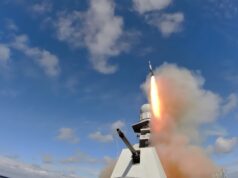
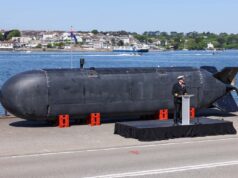
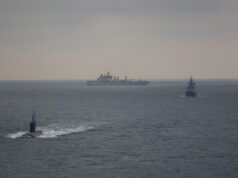
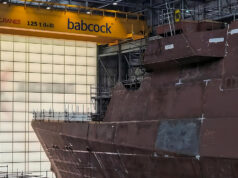
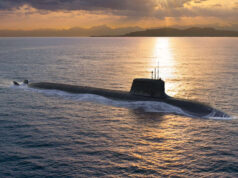
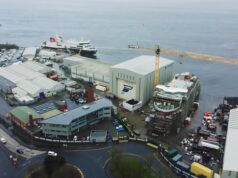
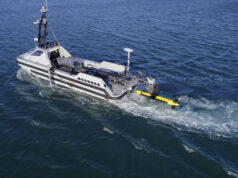
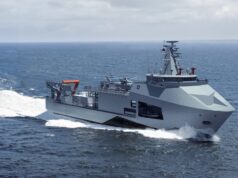
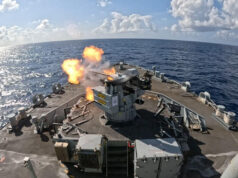

I am probably being thick but I have read the article 3 times now and still can’t work out if the upgrades have fixed the propulsion problems or if that still needs to be done.
I think that this is the first of the six to fecievethe upgrade!
yeah it is not 100% clear, but i think this is what they are indicating and the description of what has been changed appears to be aligned with this.
1 fully operational and dependable destroyer, is a major upgrade on 6 partially dependable ones.
I don’t think that there has been even one operational type 45 for some time.
A very quick google search turns up HMS Duncan as being deployed with Standing NATO Maritime Group 2 in the med (I’m pretty sure there’s at least 1 other deployed), so I’m not sure what you mean here.
Doh!
Hi Steve, when you sail into Pompey harbor you can clearly see ‘three 45’s’ in the inner basin and clearly not going anywhere.
Really? I will give you just one example (there are many). HMS Duncan led NATO’s Standing Maritime Group 2 for 6 months until July this year.
@Alan Stillwell, whilst that is true, Grubbie wondered if there was even one operational Type 45, to which I was responding that yes, there is/are.
Ok,but I was looking out from the spinnaker tower a couple of weeks ago and I thought that I counted at least 5 possibly 6 .It’s a bit difficult to see as veiwing is mainly the orientated the opposite direction.
Actually despite what I said I think there have been very few deployments over the last 12 months. I was under the impression there were more but could only find the Duncan example and then Diamond which had to withdraw from its 9 month deployment to the Gulf after only a matter of a few weeks. It may also have broken down a few months ago if you believe the tabloids.
whats the story with dauntless? when will return to service as a warship and not a classroom?
Yipeeeee
So what are these “new gas turbines”?
MT30?
New build WR21?
Or is it actually misdescriprion of the long discussed new diesel gen sets?
It’s left me a bit confused.
Just refurbished WR21.
Diesel gensets haven’t been added yet.
Apparently RR has deployed some improvements to the ships already that have mitigated a lot of the issues.
So they replaced the faulty WR21’s with good WR21’s ?
That just doesn’t seem likey or possible without cutting big holes? so is this just obfuscation of what was actualy done? Maybe some reworking of the electrical gear to handle “graceful degradation “ rather than acute failure, maybee some modifications to the turbine intercooler to be more effective. I wonder if there isn’t some hope the issues can be tweaked out of existence with re fitting bigger engines
The WR-21’s aren’t faulty. As part of a refit they’ll remove them for deep maintenance. The WR-21 can be removed via access routes in the ship, the diesel gensets can’t. RR has already deployed some fixes to make the problems less sever, and by all accounts these have been effective. But the intercoolers can’t be completely fixed. The 3 bigger diesel gensets replacing 2 smaller ones is very much belt and braces with the improvements RR is doing.
Still no mention of a Mk41 VLS fit…
Never going to happen with the current budget. If Williamson gets his extra 2billion (minimum) then maybe in a few years it might be possible. I’m also not getting my hopes up about anything useful being put in the Mk41 for Type 26 given the current climate of financial woes and not wanting to buy any new expensive equipment.
Sadly Chris, I tend to agree. It’s a real shame as these ships – as few as they are – have great potential and shouldn’t be wasted.
That’s’ the problem with ‘fitted for but not with’…. it becomes ‘fitted for but never with’.
They are too precious. They have in effect become a HVU not an escort.
its a phrase too often used, i’d like to see the archers fitted with the 20mm cannon they were designed to carry then used on anti piracy in a squadron size deployment or exrta support at gibraltar.
https://ukdefencejournal.org.uk/tender-issued-for-new-fast-patrol-boats-for-gibraltar/
No mention of armament but a step in the right direction.
The question that I am unable to get an answer for, why is the failure catastrophic?Why can’t the ship plod on at a much reduced speed and maintain its basic fighting ability when the gas turbine fails?I would have thought that 2 diesel generators (or even one)would be enough to prevent the ship being left dead in the water. Warships should be able to cope with major damage. The type 45 power management system dosnt seem to have enough redundancy. I may have misunderstood, does anyone know any more knowledge on the subject?
Could it maintain speed to stay with its charges though if it is escorting other assets?
(Chris H) Grubbie – the term ‘catastrophic’ is more an engineering term than maybe as you interpret it. The original design of the intercoolers intended that there would be ‘controlled degradation’ while the GTs wound down and reset leaving the diesels running. What was actually happening was ‘catastrophic degradation’ where ALL engines shut down hence total lack of power. The system is then reset, diesels fired up followed by GTs.
Its worth repeating that no Type 45 has failed to complete any mission due to this power loss issue. The RN are very good at finding ways to keep a ship going.
as an ex R.N ENGINEER I’WAS ALWAYS AWARE THAT ONE PROBLEM CAN OVERSTRAIN SOMETHING ELSE, THEN YOU’VE GOT MORE ISSUES, if a ship running on reduced power encounter a rough sea state, thing like hydraulics and steering gear are over worked(to keep going strait) and there can be more seal problems
This report is misleading. The upgrade wasn’t to install new gas turbines, it was to install the redesigned intercooler/recurperator component to the existing WR21s. The diesels on T45s will however be replaced from 2020.
Sounds a reasonable explanation rather than the main story
Sound right MattG
We should remember one of the key advantages of building ships around gas turbines is that they can be exchanged via the uptake if need be.
Not on a T45. WR21 is modular and shouldnt need to go up the down takes. You can exchange bits and pieces in situ…
However…
The intercooler was designed like the engine to last the lifetime of the vessel. That bit of design didn’t work out to well. It is a complete bastard to get at and involves multiple scaffold builds and undoing parts of the engine room and intercooler housing to get to it…most of these parts having not been designed for access.
To remove big items from the spaces there are access routes via soft patches in the deck. This does restrict access in and around the machinery spaces but it is workable.
i’m not familiar with the machinery space layouts but i was involved in the early 80’s in a twin engine change(hms birmingham) that took a total time of 26 hours! can this be done as fast on the latest ships?
shame weren’t designed with that proviso for main machinery replacement
getting dauntless fixed and operational should be a priority. if only to reduce the load the rest are carrying
Who took responsibility for this problem and did they contribute financially to the fix?
My understanding is that MoD insisted on the design over BAe’s objections because they wanted Rolls Royce WR21 GTs as a political ‘Win’ over the tried and tested GE LM2500 (a ‘foreign’ supplier)
If memory serves me correctly. the Mod wanted the LM2500 and it was a political decision to go with the WR21
It’s an interesting issue. Did mod specify.. And I generalise .. “Fit to sail the seveven seas” or did it specify.. ‘fit to sail the seven seas day and night all year round’
If the latter then Bae should stump up the bill as it sound like they placed a cap on upper level operating sea temp ranges.
If the Mod stated (in proper specification terms) something that matched the first statement then the Mod got what they asked for. It can sail the seven seas but you just have to be selective when you do so.
If the Mod set an upper operating temperature limit along the lines of… Be able to operate in sea temperatures of at least xx deg C…. And that temp was say an average temp rating rather than a possible maximum then someone in mod should be hung out to dry.
Is specification was light but manufacturers sales blurb claims fit for all conditions etc then manufacturer should still be pursued and part of selection criteria would be capability offered / claimed rather than specified.
Would love to forensically strip the entire sourcing process apart to understand the root issue
P
both BAE and northrop grumman have been told the bill will be theirs to pay.(statement by gavin williamson)
Flick Drummond lost her job as MP for Portsmouth South 14 months ago.
Like others not sure what has been fixed. 2 new gas turbines, but no new diesel generators. New WR21’s? or different turbines? Is this the installation of the new recuperator which is the EIP part of the Project?
https://www.gov.uk/government/news/multi-million-pound-contract-to-enhance-royal-navy-type-45-fleet-resilience
First in class to be fixed by 2021?
diamond deploying for 9 months!! watch this space.
From the Portsmouth News 2 8 2018
“While specific detail of the work undertaken cannot be released, it did include fitting of two new gas turbines, as well as new signals intelligence and surveillance equipment.”
Read more at: https://www.portsmouth.co.uk/news/defence/two-royal-navy-warships-return-to-portsmouth-after-major-upgrades-1-8588663
Hi Mike..Agreed, also saying at a cost of £280 Million, is that per ship, or, for all of the type 45’s
I think the main story is confusing, the work undertaken on HMS Defender is not related to project Napier.
Regards the £280m it is my understanding that’s cover the installation of new diesel generators for all 6 T45s
(Chris H) Mike Saul – Napier isn’t just the power upgrade / fix. Napier Part I is to upgrade current equipment and combat systems. Part II will be the Power upgrade / fix.
for all of them, BAE were crowing about getting the contract to do it.
https://www.janes.com/article/80634/first-uk-type-45-at-sea-with-shaman-cesm-fit
An explanation of the new electronics fitted.
The Type 45’s have been a disaster! 18 months in A&E? Did BAE better known as the ‘untouchables’ foot the bill? Thought not. How many hundreds of millions to be spent on the others? 24 escorts which is what this navy needs is a distant dream. The waste of public money is beyond parody. Six, which should have been at least 8 anyway, more useless undergunned ships is hard to imagine. For a billion apiece the Russians would have these bristling with hardware with something to spare and better propulsion probably. Just build more type 23’s and kit them out appropriately! Superb vessels! Call them 26 or 31 but give them 48 cell anti air and anti ship missiles, 2087 sonar and we’re done. Over simplistic but you know what l mean!
Fishing for a bite….nibble ….nibble….
This might sound odd but it would take nearly as much effort to build new T23s as it would a new ship. Crazy but true.
There have been lots of mistakes with T45. SeaViper is great but the thing it is bolted too not so much. The RN does OK at keeping things going but it shouldn’t have to go well to keep things going; further the RN’s depth engineering grows shallower by the year. And it doesn’t matter how much better SeaViper is than Aegis the US has active Aegis 87 hulls active. And if excuses can be made for T45’s performance well then in comparison the performance of Burke’s and Tico’s then is comparison stunning.
i always thought that some of the t42’s could have had life extending refits with artisan sea ceptor e.t.c some of the 42’s such as gloucester could have still been part of the fleet. just as a bristol, refitted and rebuilt from the inside outwards might have been an option either might have seen us with a larger fleet than we currently have. having served briefly on exeter, i can say what fine ships the 42’s were, hampered mainly by the appallingly slow sea dart reload set up.
(Chris H) Bill – Your usual nonsense is wearing a bit thin … You dismiss probably THE most capable air defence destroyer in the world like its a piece of Meccano? It does not need to be heavily armed as its a DEFENCE ship and not an attacking ship like the US Missile Cruisers (which are not being replaced!).
To compare UK shipbuilding with Russian is frankly absurd. Have you seen what they produce? Would YOU work for piss poor Russian wages in very dangerous conditions throwing together sub standard kit under a communist regime that covers up each and every failure? No so why expect anyone here in the UK to do the same? Safety comes at a price and rightly so.
Be thankful you are having your usual Anti- BAE rant on here and not in Russia because the Government there would lob a dose of Novichock through your letterbox ,.
if the u.k bought one retiring ticondaroga cruiser from the u.s per year , and could find a way of operating it with less than a 300+ crew size these cruisers were designed and have been used fo battlegroup duties since the first was commissioned the advantage of this? defence for Q.E and prince of wales and the fact that they are already built. there are 5 in reserve states at philadelphia inactive fleet facility.as well as the giant supercarriEr john f kennedy available on a DONATION/MUSEUM. BASIS!!
Let us not forget the conventional Horizon frigates………
2 x GE/Avio General Electric LM2500Plus TAG, 20.500 kW (27.491 hp) each
2 x diesel engines SEMT Pielstick 12PA6 STC 4.320 kW (5.793 hp) each
4 x diesel engine generators Isotta Fraschini V1716T2ME, 1.600 kW (2.146 hp) each
So Rolls Royce have fixed the Northrop Grumman intercooler?
With the benefit hindsight it would have been better to have chosen the Dutch/German route for the T45 once the NATO frigate project collapsed.
This would have been similar to the De Zeven Provinciën-class frigate. This would have meant APAR radar instead of Sampson and US SM2 missiles instead of Aster 30. But we would got a 127mm modern gun, SSMs, RR Spey GTs, a sub hunting sonar and weapons all for half the cost of a T45.
No solution is perfect, but the t45 as designed and built was wrong on several different levels
Um. Yes it would have been a better starting point for us. The only aspect of De Zeven Provinciën-class frigate that doesn’t fit is the size of the hull. Bigger is better for us.
David – bigger would be better certainly if all the extra space was utilised – but as far as we can see this is not likely to be the case.
I’m not sure if the UK gets any industrial workshare on Aster but it’s a much more capable missile than sm2. Samson also performs better for over the horizon search than the 4 Panel Thales radar plus its a UK design. The big advantage of De Zeven is it can take SM6 if required (it also looks better IMHO). If we really wanted to save money and prob win exports the Spanish route would have been better.
I know even less about where we are at after reading the article….than I did before!
Don’t think the full refit has been done, even to just the one vessel.
They have installed new listening sensors to hack and spy on enemy communications, a gap in capability that was lost with the t22’s. During this fit they have swapped out the rolls Royce engines. This is not the Napier fix, which is the installation of new diesel gennies.
The article in Save th Royal Navy is far clearer, take a look.
Many thanks, understand now.
Appreciated.
(Chris H) T.S – Can I gently correct you? In this first stage of Napier they have not changed any diesel equipment. While the report is confusing they may have also replaced the compressors on the GT but not the whole GT.
Rolls Royce did not supply the original 2 diesels per ship. They are Wartsilla diesels and it is these that will be replaced by 3 x Rolls Royce MTU diesels in Part II of Napier later on.
believe this or not i wrote to my m.p asking him to forward a question to the defence secretary he did, and unbelievably they replied! my question was, has the u.k considered acquiring a ticonderoga every year as the u.s.n retires theirs the reply was that they had, but ,get this, it was the CREW SIZES 300+)( and equipment incompatibility!!!!! that swung the argument away from the idea the ticondaroga cruisers have been the backbone of the u.s carrier groups ever since the first entered service. a look at the naval inactive ships(kept inr eservr register shows where the u.k might be better shopping. maybe the u.k could have got a couple of nimitz class carriers with CATOBAR, cheaper than building queen elizabeth and prince of waleshttps://www.google.co.uk/imgres?imgurl=https%3A%2F%2Fi.pinimg.com%2Foriginals%2Fb7%2Faa%2F34%2Fb7aa342b1570ae67d3daa79367fe94df.jpg&imgrefurl=https%3A%2F%2Fwww.pinterest.ca%2Fpin%2F730005420820598328%2F&docid=9lWWXdbUQOX3OM&tbnid=gYnPRSqbRUogHM%3A&vet=10ahUKEwi0_e25_-TcAhWUecAKHQLyDewQMwg_KAAwAA..i&w=800&h=536&itg=1&bih=662&biw=1366&q=inactive%20ships%2 0bremerton%20wa&ved=0ahUKEwi0_e25_-TcAhWUecAKHQLyDewQMwg_KAAwAA&iact=mrc&uact=8